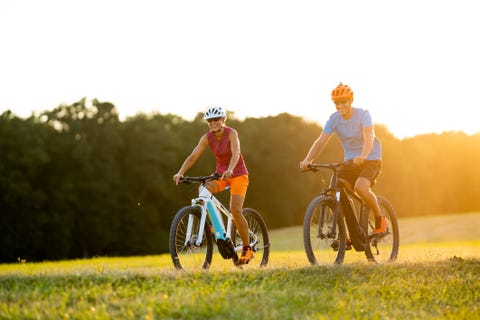I’ll say upfront I’ve not ridden an e-bike, but I’m seeing more of them around all the time. I’ve been struggling a little with my view towards electric bicycles, but as I read more studies, I’m more at peace with them. I’m not talking about the “DUI” bikes, those bicycles retro-fitted with a gas lawn mower motor that spew fumes and noise and are not permitted on trails, no matter what their operators seem to think. Electric bikes are permitted on trails, but not over 20 miles per hour, the trail speed limit.

Bicycling Magazine has an article from Sept. 2 about “How do fitness levels of e-bikers compare to those who ride regular?” It begins with the following finding: Recent research published in Transportation Research Interdisciplinary Perspectives found that those who ride e-bikes get more exercise minutes per week than those who ride normal bikes. E-bikers also reported significantly longer trip distances, whether riding an e-bike or conventional bike. Among the 10,000 riders researchers from the University of Zurich followed for a year, the e-riders had a slightly higher activity rate.
Another researcher found that people would make trips with an e-bike that they wouldn’t with a conventional bike because they viewed the trip as too long, too hilly, or took too much time. E-bikers do also ride conventional bikes.

All this makes me re-think any pre-conceived notions I may have had about these riders. If an e-bike takes a person out of a car and puts them on a bike they still have to pedal, what could be wrong with that? I have met e-riders who do so in order to not arrive at work sweaty, which is apparently an insurmountable problem for some (I still think it can be dealt with.) Also, an e-bike allows people to ride together when fitness levels are too different for it to happen otherwise, and to tour when it wouldn’t be feasible on conventional bikes.

Today I waited at an intersection near campus with another regular cyclist and an e-cyclist who opted to walk across the intersection when the light turned green, even though cyclists no longer have to do that. Soon though, he passed us and sped ahead. This made me think of another article I’d seen on Bicycling.com:
How to Ride an E-Bike Safely: 6 TIPS FOR MANAGING THESE FASTER, HEAVIER BIKES. I’m not saying he was doing anything dangerous, but he was going considerably faster uphill than we conventional cyclists were. Motorists perceive cyclists are going to travel a certain speed and if faster (this happened to me often in China) will overestimate the time they have to proceed before you get there. Everyone has less reaction time with increased speed, so it’s even more important for the e-cyclist to pay attention to traffic. 50-200 more watts of power means not only motorists, but other cyclists and trail users won’t hear you coming up even faster than usual, so it’s even more important to announce your presence. Faster speeds and a heavier bike mean it’s necessary to start braking sooner at crossings, and to slow down more for corners. New riders should start out more slowly until they’re used to the difference.
Riders with mobility issues should understand that the bike weighs an extra 20 lbs. and mounting and dismounting can cause a tip-over and an injury. A step-through bike, or one with a more angled top tube may be better suited for these riders. In China older men didn’t have a problem with riding step-through bikes, but here guys still seem to have issues with some frame styles. If your hip socket says throwing a leg over is not a good idea, a step-through will keep you on a bike.

Finally, don’t get me started on the extra importance of wearing a helmet at higher speeds. Most of the e-bikers I’ve seen were not wearing them. How many extra heads do you have that you can spare one?
